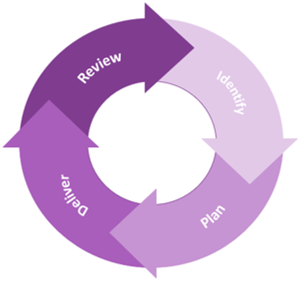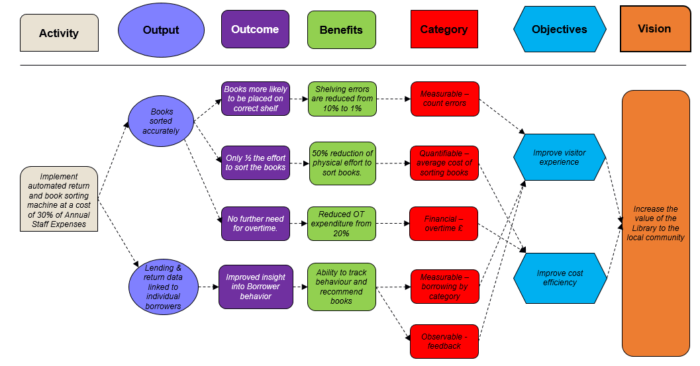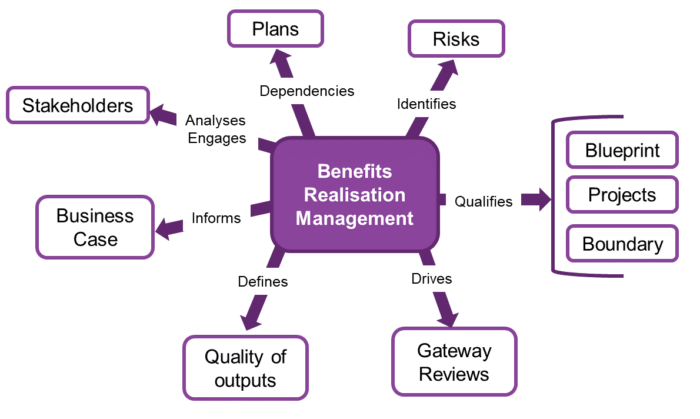Benefits Management
A benefit is a result that a stakeholder perceives to be of value." David Waller, Benefit of Experience.
Understanding the benefits helps us to confirm the viability (whether the initiative is worth doing) and helps understand the alignment of activity in delivering the vision.
Benefits Management involves identifying and agreeing the benefits and how they will be measured, monitored, managed and delivered throughout the project.

Benefit types can include: Cost / Time / Quality.
It is important for each benefit to be assigned an owner as the realisation of the benefit may not occur until after the initiative closes out. The Sponsor ensures ownership of the benefit.
Benefits Management Templates
The Benefits flow chart below shows how all of the various Benefits documents fit together, all of which can be found below.

Benefits Strategy and Management Plan
The Benefits Management Strategy and Plan are part of one combined Word document which acts as the overarching document describing the initiatives strategy and management activities relating to how Benefits Management will be managed/ approached. This document describes processes, roles and responsibilities, tools, templates and products required throughout the programme to manage the benefits to delivery, referencing the remaining documents as appendices.
The Benefits Strategy and Management Plan template is currently in development. (Due 2021)
Benefits Mapping Grid
A Benefits Mapping Grid is a tool to aid review and mapping of the benefits by discussing and reviewing the level of impact of a benefit against the ease of its implementation. Depending on where the benefits are placed on the quadrant will help inform the viability of the initiative and the ongoing priorities.

The benefits that are in the top left quadrant are likely to have a high impact on the objectives but will also be difficult to implement. These benefits have potential but the impact to cost and resources should be carefully considered. Benefits in the top right quadrant should be prioritised as these are simple to implement and have a high impact on the objectives; these benefits fall into the zone of high priority. The bottom right hand quadrant are quick wins, simple to implement but low impact, that could be used to show early progress and results. Finally, any benefits in the bottom left quadrant are to be avoided as they require a high level of effort to implement but will have limited impact.
DOWNLOAD the Benefits Mapping Grid
Benefits Dependency Network
This Benefits Dependency Network template should be used at the benefits identification stage, when identifying the need or defining the scope.
A Benefits Dependency Network is an overview of an initiative's desired outcomes, objectives and benefits, and associated drivers and dependencies.
Benefits dependency networks are usually constructed from right to left, detailing the vision, objectives and what is to be achieved on the right, with the outcomes required to cause these objectives to happen detailed on the left.

Benefits Log
The Benefits Log is a template to record a the benefits identified as a first step in a simplified form. The Benefits Log helps to aid collective review, discussion, and capture of the benefits, their interdependencies and links to the activities. The log captures similar information to the Benefits Dependency Network above, showing how the activities planned contribute towards objectives and the vision, and what measures will be used.
Benefits Matrix and Profiles
The Benefits Matrix template is used to record the key information regarding the benefits identified. The matrix provides a central place from which to track and review the benefits for the initiative. Benefit Profiles provide a more detailed record for individual benefits.
Benefits Realisation Plan
Whilst Benefits identification and profiling should be carried out during establishment of need or definition, Benefits Management continues to play an important role through the delivery phase in the form of Benefits Realisation Management. This process relies heavily on integration with other initiative controls disciplines, in order to:
- Understand the actual progress of initiative delivery compared to forecast;
- Monitor and react to the impacts of intended and enforced change; and
- Confirm that the investments will deliver the required outputs.
- The information captured in the definition phase will be used to support monitoring and ongoing management of the Benefits and supports the identification of opportunities to increase Benefits realisation.
A Benefits Realisation Plan can assist in accurately tracking the Benefits and Dis-benefits towards their final realisation.
Understanding Benefits helps us to confirm the viability (whether an initiative is worth doing) and alignment of activity in delivering a vision. So the Benefits Realisation Plan provides a common reference point within which to show the magnitude and timing of forecast benefits realisation.
A Benefits Realisation Plan is therefore the basis for ongoing monitoring, management and reporting of benefits during initiative delivery. Trends, issues and opportunities should be evaluated to understand the impacts on eventual benefits realisation and can be a useful tool to ensure the long-term impacts of change are considered when reviewing change requests.

Click the DOWNLOAD button to access the combined Benefits Management toolkit including the Benefits Log, Benefits Matrix, Benefits Profiles and Benefits Realisation Plan.
DOWNLOAD the combined Benefits Management toolkit
Hints & Tips
- This is a simple and practical way to relate the objectives to the benefits and the outputs. This can also be represented in a network diagram.
- Identify and agree high level benefits (normally begin with words such as Improve, Increase, Reduce).
- It is important that the baseline measurement is captured prior to the implementation of any improvements.
- Once the improvement(s) have been implemented, determine a suitable ongoing timescale to capture the post-improvement data using the same process as before.
- Consider both qualitative and quantitative measures.
